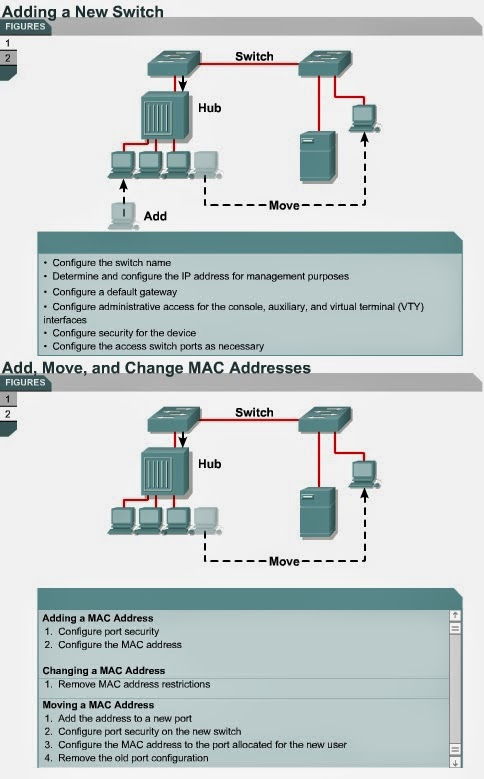Broadcast storms
7.1.4 page will explain the effects of broadcasts and multicasts in a switched network.
Broadcasts and multicasts can cause problems in a switched network.
Multicasts are treated as broadcasts by the switches. Broadcast and multicast frames are flooded out all ports, except the one on which the frame was received.
If Host X sends a broadcast, like an ARP request for the Layer 2 address of the router, then Switch A will forward the broadcast out all ports. Switch B is on the same segment and also forwards all broadcasts. Switch B receives all the broadcasts that Switch A forwarded and Switch A receives all the broadcasts that Switch B forwarded. Switch A forwards the broadcasts received from Switch B. Switch B forwards the broadcasts received from Switch A.
The switches continue to propagate broadcast traffic over and over. This is called a broadcast storm. This broadcast storm will continue until one of the switches is disconnected. Since broadcasts require time and network resources to process, they reduce the flow of user traffic. The network will appear to be down or extremely slow.
The next page will discuss multiple frame transmissions.
A redundant switched topology may cause broadcast storms, multiple frame copies, and MAC address table instability problems.
The next page will discuss broadcast storms.
7.1.4 page will explain the effects of broadcasts and multicasts in a switched network.
Broadcasts and multicasts can cause problems in a switched network.
Multicasts are treated as broadcasts by the switches. Broadcast and multicast frames are flooded out all ports, except the one on which the frame was received.
If Host X sends a broadcast, like an ARP request for the Layer 2 address of the router, then Switch A will forward the broadcast out all ports. Switch B is on the same segment and also forwards all broadcasts. Switch B receives all the broadcasts that Switch A forwarded and Switch A receives all the broadcasts that Switch B forwarded. Switch A forwards the broadcasts received from Switch B. Switch B forwards the broadcasts received from Switch A.
The switches continue to propagate broadcast traffic over and over. This is called a broadcast storm. This broadcast storm will continue until one of the switches is disconnected. Since broadcasts require time and network resources to process, they reduce the flow of user traffic. The network will appear to be down or extremely slow.
The next page will discuss multiple frame transmissions.
A redundant switched topology may cause broadcast storms, multiple frame copies, and MAC address table instability problems.
The next page will discuss broadcast storms.
Multiple frame transmissions 7.1.5 page will explain the effects of broadcasts and multicasts in a
switched network.
Broadcasts and multicasts can cause problems in a switched network.
Multicasts are treated as broadcasts by the switches. Broadcast and multicast frames are flooded out all ports, except the one on which the frame was received.
If Host X sends a broadcast, like an ARP request for the Layer 2 address of the router, then Switch A will forward the broadcast out all ports. Switch B is on the same segment and also forwards all broadcasts. Switch B receives all the broadcasts that Switch A forwarded and Switch A receives all the broadcasts that Switch B forwarded. Switch A forwards the broadcasts received from Switch B. Switch B forwards the broadcasts received from Switch A.
The switches continue to propagate broadcast traffic over and over. This is called a broadcast storm. This broadcast storm will continue until one of the switches is disconnected. Since broadcasts require time and network resources to process, they reduce the flow of user traffic. The network will appear to be down or extremely slow.
The next page will discuss multiple frame transmissions.
Broadcasts and multicasts can cause problems in a switched network.
Multicasts are treated as broadcasts by the switches. Broadcast and multicast frames are flooded out all ports, except the one on which the frame was received.
If Host X sends a broadcast, like an ARP request for the Layer 2 address of the router, then Switch A will forward the broadcast out all ports. Switch B is on the same segment and also forwards all broadcasts. Switch B receives all the broadcasts that Switch A forwarded and Switch A receives all the broadcasts that Switch B forwarded. Switch A forwards the broadcasts received from Switch B. Switch B forwards the broadcasts received from Switch A.
The switches continue to propagate broadcast traffic over and over. This is called a broadcast storm. This broadcast storm will continue until one of the switches is disconnected. Since broadcasts require time and network resources to process, they reduce the flow of user traffic. The network will appear to be down or extremely slow.
The next page will discuss multiple frame transmissions.




